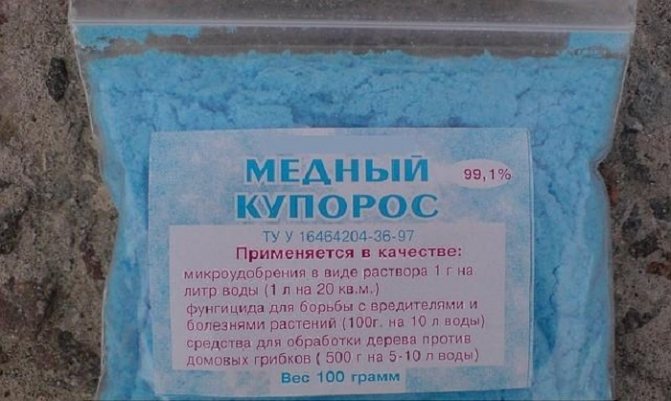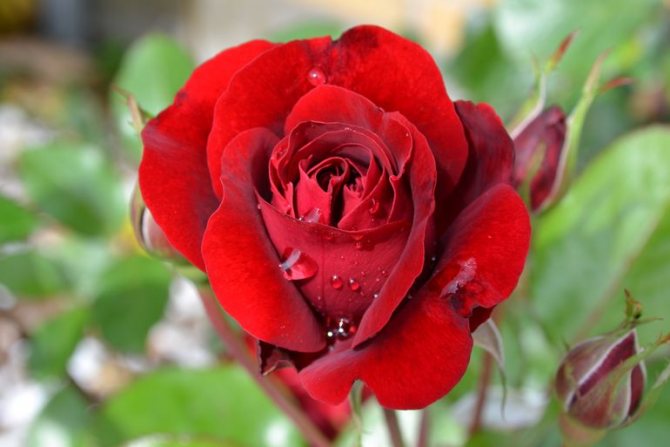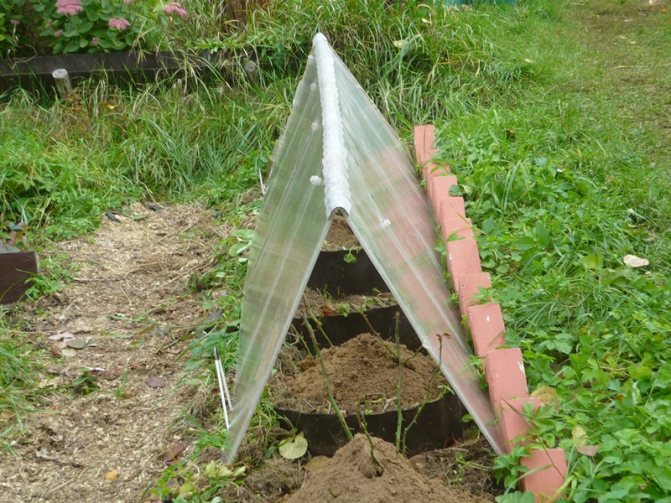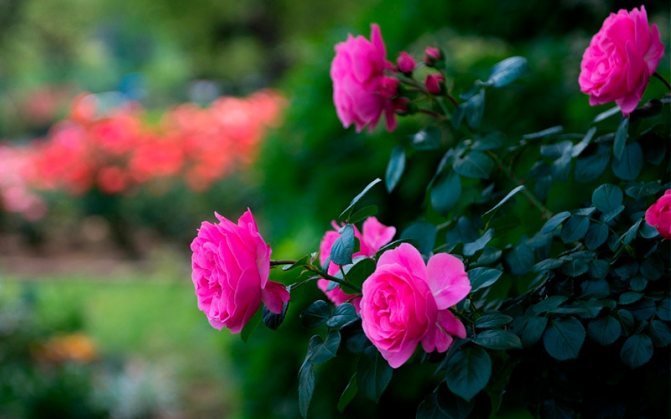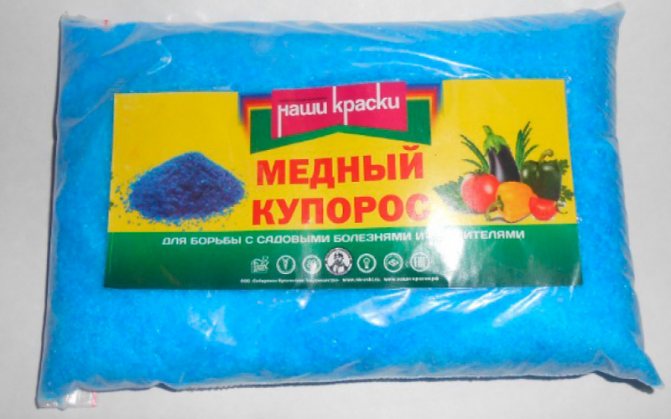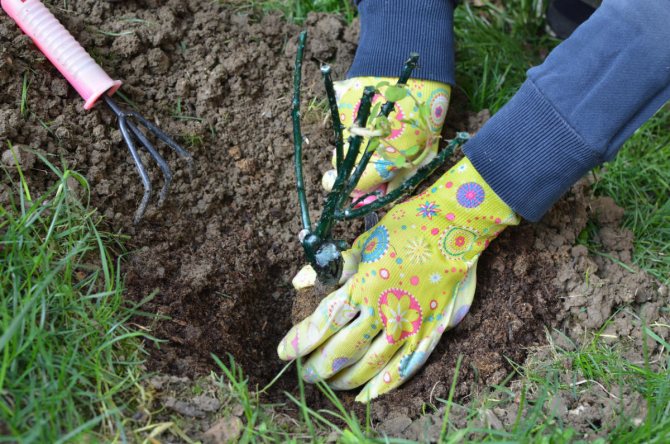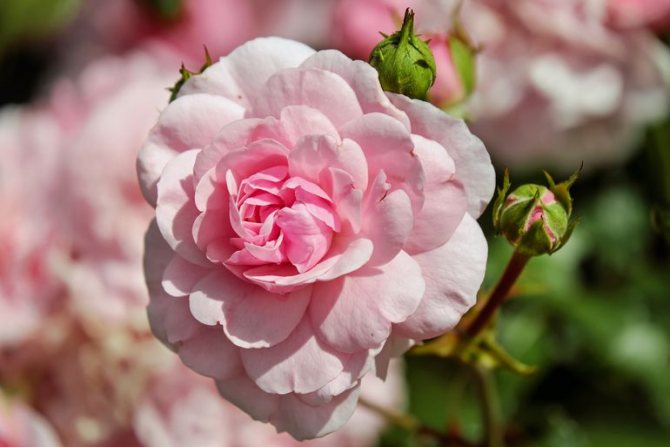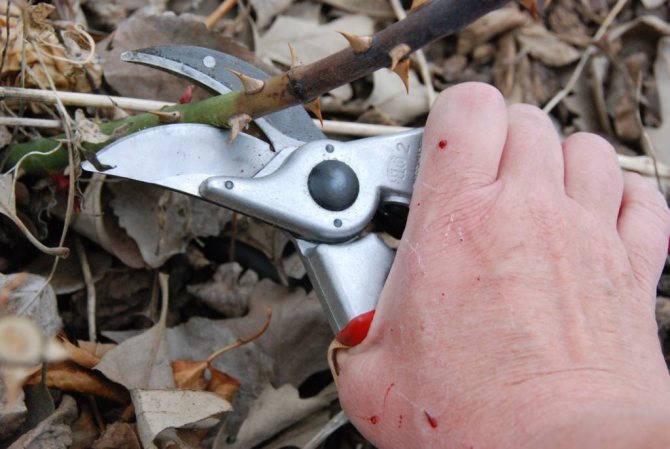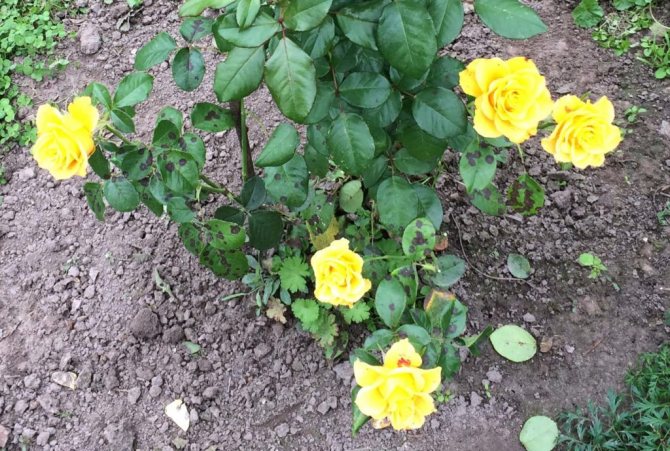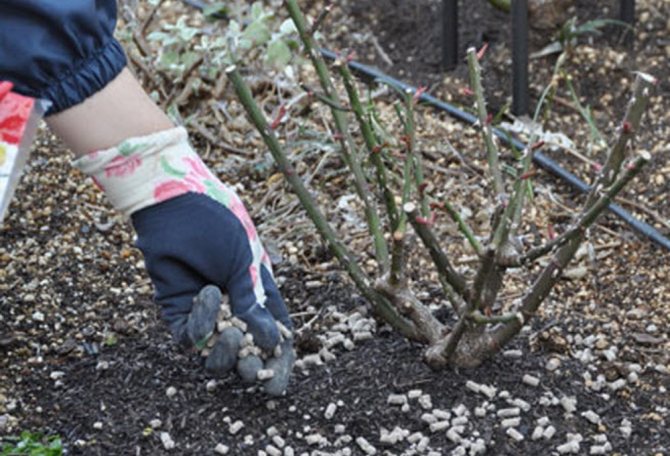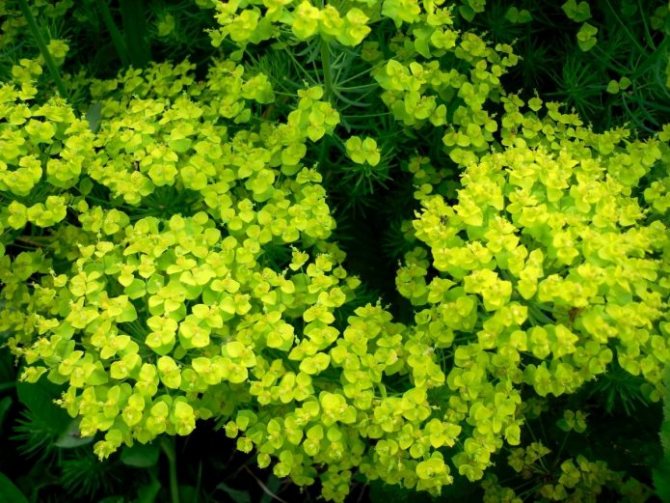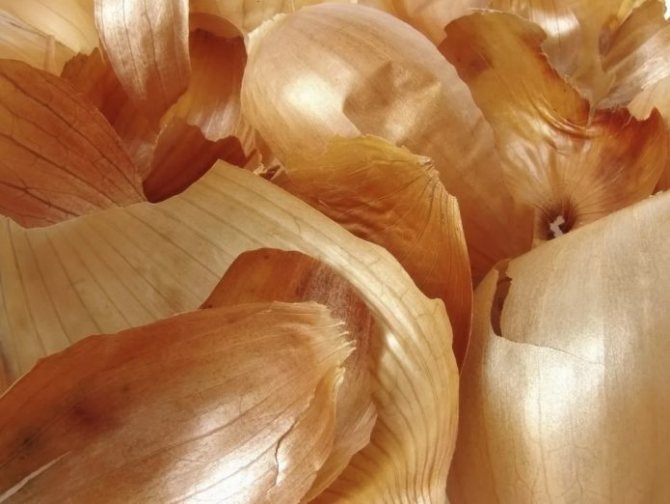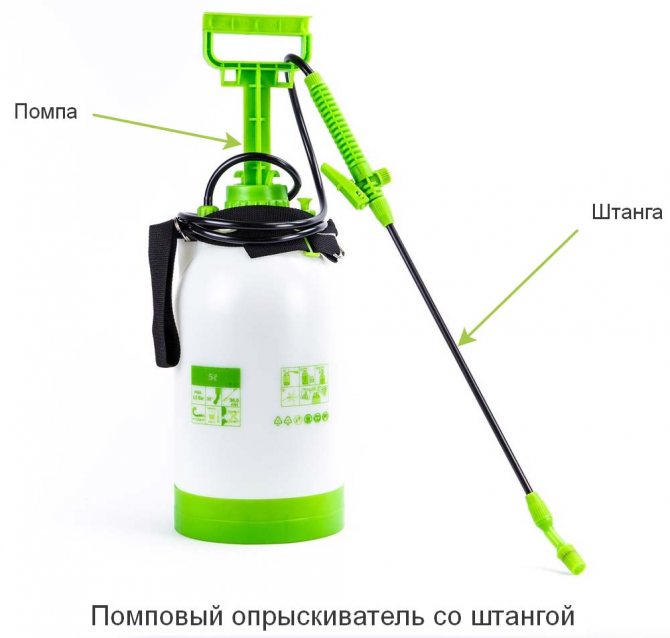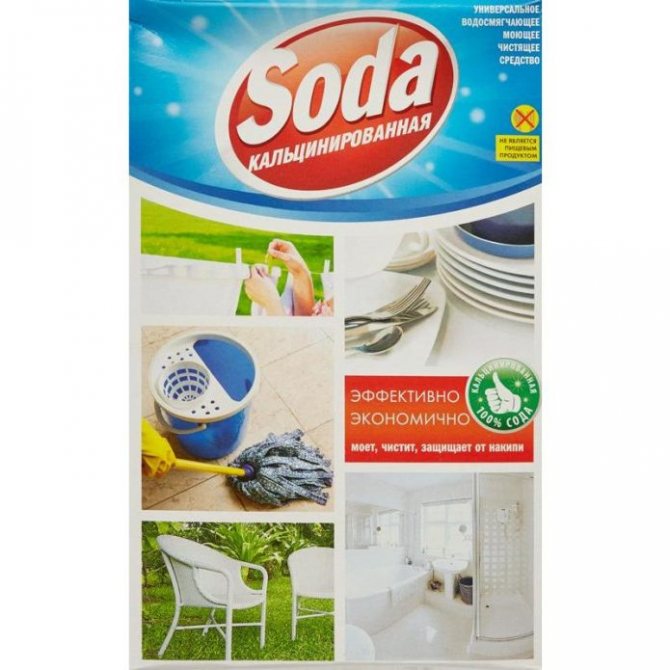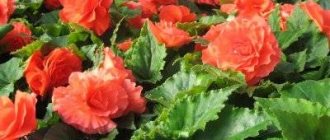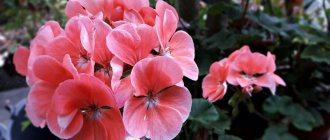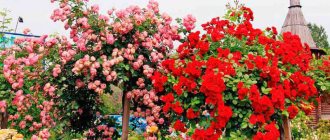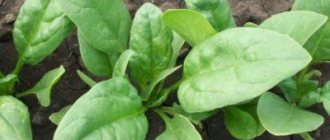1 March 2019 ditim Main page »We know how Views:
The rose is called the queen of flowers for a reason. Legends were made about her, the image of a flower is found in the symbolism of religions, esotericism, on coats of arms, etc. It is a flower of celebration, celebration, sacred rite. Rose oil, petals are used by women to maintain their beauty and youth. Delicious jam is made from rose petals. Florists know what kind of care a rose requires, but all efforts are rewarded a hundredfold. They begin to take care of the rose in early spring. With the arrival of March, it is time to air the shelters, prune, process roses from diseases and pests. An amateur florist Lyudmila Melnikova from Belgorod shares her personal experience of processing roses in spring:

Preparing roses for protective spraying
An important role in preparing roses for winter is played by the introduction of phosphorus - potassium fertilizers. They not only strengthen the root system, but also improve leaf fall. This is an essential stage in the autumn work. Often, on long-blooming varieties of roses, the leaves remain on the shoots until frost and do not fall off. They have to be torn off forcibly. It is much easier to do this if you use potassium monophosphate. After it, the leaves are separated much easier.
Tip # 1. You can not break off the leaves abruptly. This can damage the bark on the shoots, and therefore increase the possibility of infection with fungal diseases. The procedure is best performed in several passes, removing those leaves that are easily separated.
The treatment of bushes with protective agents is carried out only after all the leaves have been disposed of. If there are flowers on the shoots, only the petals are removed, and the boxes are left. If you cut them off, the plant regards this as a signal for the activity of the nearest buds. If the autumn is warm, they have time to germinate and die with the onset of frost. And that means they freeze over. That is why those varieties that are not pruned for the winter are freed from the leaves, and the fruits are not touched.
My hideout experience
There are a great many types and varieties of roses. There are winter-hardy ones, there are very tender ones. For example, tea-hybrid or floribunda I cover for the winter, and park ones, for example, hibernate just under the snow, which I add to it in the process of cleaning the paths. Rather, I clean the garden paths to add snow to the roses. But sissies in late October-early November, when the daytime temperature for several days confidently keeps from -1 degrees to -5 degrees, I cover them with five-liter plastic bottles from mineral water. When it snows, I just add it to the banks. It turns out snowy hills, which keep the bushes until spring. As the long-term practice of such shelters has shown, the bushes feel great even in winters with little snow. In the thaw, they do not support, mice do not gnaw them. In the spring I take off the shelter when all the snow melts, and the daytime temperature is kept at the level of 5 - 7 degrees Celsius.
Chemical remedies for the prevention of rose diseases
Many gardeners try to choose roses that are resistant to diseases, but even they should be protected from possible diseases. Even if your plot is perfectly tended, danger may arise from a nearby garden or from wild plantings. This is why you shouldn't rely on chance and treat roses for infection. Moreover, if there are obvious symptoms of the disease.Spraying with fungicides in autumn will prevent pathogens from persisting until spring. This way you can avoid spreading it.
For this, both proven and modern drugs are used.
One of the most famous substances for the autumn treatment of roses - this is iron vitriol... For autumn spraying of roses, a solution is prepared from 300 g of the substance and 10 liters of water (3% solution). Processing is carried out after complete dissolution of the crystals (See also the article ⇒ Autumn treatment of roses with iron sulfate).
Tip # 2. Pay attention! Iron vitriol can only be diluted in glass, plastic or enamel containers. In metal containers, a chemical reaction takes place with the release of harmful iron oxide. When working with the drug, it is necessary to observe the precautions for the means of the third hazard class.
Recently, gardeners are increasingly using other means for the prevention and treatment of rose diseases. The most common of these are powdery mildew and black spot. The following drugs are effective against them:
| Name | Features application and dosage for autumn processing | Estimated cost |
(at the prices of "Lerau Merlin")
15 g for 15 l of water
Speed
The drug is sold in ampoules or vials.
The recommended cooking rate is 2 ml per 10 liters of water.
Disadvantage - high cost in comparison with similar drugs.
RUB 26 - 2 ml
Topaz
"Topaz": description of the drug
The drug "Topaz" is one of the fungicides - substances that are capable of destroying and preventing further development of spores and mycelium of pathogenic fungus. Thanks to this, "Topaz" can be called the most effective and safe fungicide against powdery mildew and rust. It is also used for preventive purposes, for which plants are sprayed at the beginning of their growing season.
It is noteworthy that Topaz can be used for stone and pome fruit, vegetable crops, for almost all ornamental plants (including indoor flowers), as well as for grapevines. Fungicide "Topaz" according to its instructions for use can be used for prophylactic and therapeutic purposes when processing the following list of plants:
- grapes;
- cherry;
- cloves;
- strawberries;
- gooseberry;
- raspberries;
- cucumbers;
- peach;
- roses;
- black currant.
Important! The Topaz preparation has a limited shelf life, which is only 4 years. Please note that using an expired chemical can cause significant damage to the plants, as well as render their fruit unusable.
Heading "Questions and Answers"
Question number 1. What is the best way to spray roses with chemical fungicides or biological products?
For prevention, biofungicides can be used. But, the difficulty is that most of them contain live microorganisms that suppress pathogenic flora. Their effect is manifested only at positive temperatures, in cold weather they are useless. That is why they are best used in spring and summer. For the autumn treatment of roses, it is better to use chemicals. If this is not possible, for example, due to allergies, then an ash infusion is used. It is prepared according to this recipe:
- 100 g of ash is poured into 10 liters of warm water, stirred until completely dissolved. Then they filter and spray the bushes and the soil under them.
It turns out a triple effect - feeding with phosphorus-potassium fertilizers, prevention of diseases, neutralization of soil acidity.
Question number 2. Why pick leaves on roses?
Pathogens overwinter on them, so it is better to get rid of them.
Each rose in the garden has its own story: one came from distant lands, the other was grown from a cuttings, the third was donated by a loved one. Naturally, we are worried if our favorite flowers are sick. Most often this happens in late summer - early autumn.Fortunately, there are tools to deal with the adversity.
Description of the disease
Unfortunately, black leaf spot on roses can be found in almost every place where they are grown, and on all continents. The causative agent of the disease is the fungus Marssonina rosae, its spores overwinter with infected foliage and shoots, and actively move with water droplets.
With the arrival of spring and the beginning of active vegetation, the disease begins to spread from the ground to the top of the flower. Signs of black spot can be seen as early as June - July, usually on weaker and more susceptible specimens.
In August - September, black spot appears on more resistant varieties and strong plants. Moreover, during the summer - autumn, repeated exacerbations of the disease often occur.
What does black spot look like?
On the outside of the leaf, brown, gradually blackening spots of a rounded shape from 5-6 to 14-16 mm in diameter with a yellow edging or a large number of small blurred spots appear.
Over time (5-10 days), they combine with each other, and the leaves turn black-brown or yellow, then curl and fall off. In place of the spots, "tuberosities" are formed from the spores of the fungus of a round or oblong shape, which are barely visible.
Black spot can also affect young shoots, stem (slight lignification and further drying) and sepals.
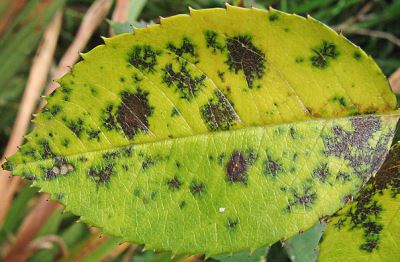

Black spot roses
What harm does it do?
As a result of the disease, the leaves fall off prematurely, which forces the rose to form new shoots. They do not have time to fully mature and freeze over the winter. Because of this, the plant grows poorly and lags behind in development. The disease is especially dangerous for young bushes.
Rose leaf diseases similar to black spot
Often, gardeners mistake other diseases for black spot due to the great similarity of most of them. Therefore, it has become a collective image. In addition, diseases have different pathogens and perhaps that is why it is difficult to cure it.
Ascochitous spotting. Brown spotting. Downy mildew. Purple spotting. Leaf spot. Ramulariasis. Septoria. Sfacelloma. Phylostictosis. Cercosporosis.
Read more on Wikipedia in the article on pests and diseases of roses - here.
Why is it so important to stop autumn diseases
Every summer, the queen of the garden is overgrown with new shoots. It is important that they mature before the onset of frost. If the rose is attacked by a disease, then the leaves are affected and fall, and this is fraught with the fact that photosynthesis will be disrupted. As a result, the bush will not receive enough nutrition, the shoots will not become lignified and will freeze in winter. In addition, diseased fallen leaves will become a source of infection the next year if not removed.


To preserve the shoots of climbing roses, it is necessary to fight diseases, otherwise they will not ripen and freeze
Fitosporin
A new generation fungicide for combating bacterial diseases and diseases caused by pathogenic fungi. The active ingredient is Bacillus subtilis 26 D. It is produced in the form of powder, paste and aqueous suspension.
- Can be used at any stage of the growing season
- Has environmental value and is safe for humans
- Can be combined with other drugs
- Low cost
- In terms of its action, it is inferior to chemical preparations
- The active substance decomposes in the sun
Read more Fitosporin M for roses
Video "Fighting Plant Diseases with Fungicides"
Fungicidal agents are a great way to cure and prevent fungal diseases of roses. The modern range of fungicides is extensive. You can choose more powerful chemicals, or environmentally friendly products based on strains of beneficial bacteria. Each of them have their own advantages and disadvantages.
In order for a garden beauty - a rose to please with its flowering and always be healthy, it is necessary to adhere to a number of rules. After purchasing seedlings, they need to be properly planted, fed, watered, pruned, loosened around the bush, protected from rodents and insect pests, transplanted, sprayed, if necessary, in a timely manner, warning against unwanted diseases.
How to process roses in early autumn
For successful wintering, roses are fed in autumn with potassium-phosphorus fertilizers and sprayed with anti-infection agents. Even if the roses look healthy, preventive measures are needed. After all, the disease does not manifest itself instantly, the infection lasts 2-3 weeks, so it is dangerous to count on luck. Roses are healed with purchased fungicides and folk remedies.
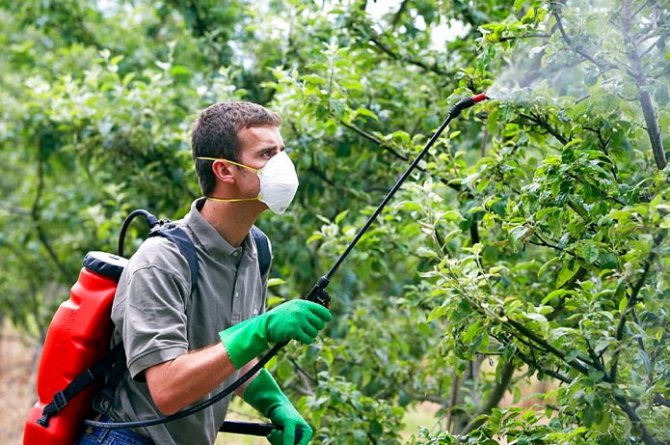

When processing plants, protect the respiratory system with a mask, and hands with gloves, take a shower after spraying
Store drugs
If the roses are not sick: leaves without spots and curling, then preventive spraying with Fitosporin solution is enough. Processing is carried out from August to mid-September: 2-4 times with an interval of 5 days. The signal for action is the onset of cold nights, heavy rains, fogs, dew. Consider an important nuance: both the upper and lower parts of the sheet are always processed.
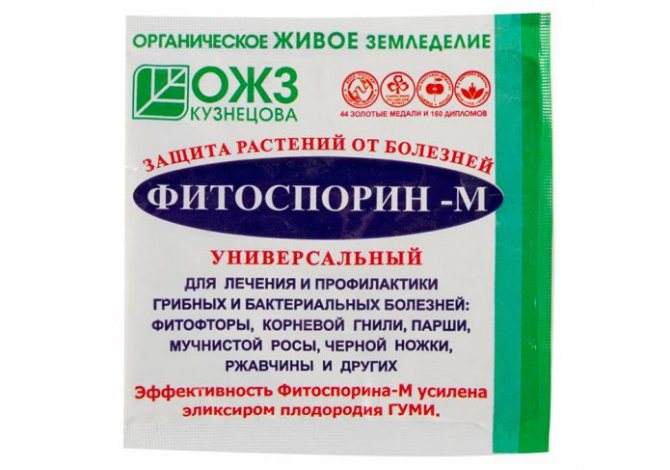

Fitosporin is an excellent biological product for the prevention of diseases, contains spores of the bacterium hay bacillus
Since August, frequent guests in the rose garden are black spot and powdery mildew. If the disease has just begun, black spots or white bloom have appeared on the lower leaves, the bushes are sprayed with antifungal drugs: Skor (Raek), Topaz or Bayleton. The listed fungicides destroy fungi, but spores must also be fought if they have formed on the lower part of the leaf. In such cases, these chemicals alternate with others: Ridomil Gold, Profit or Quadris. In total, 3-4 treatments are carried out weekly.
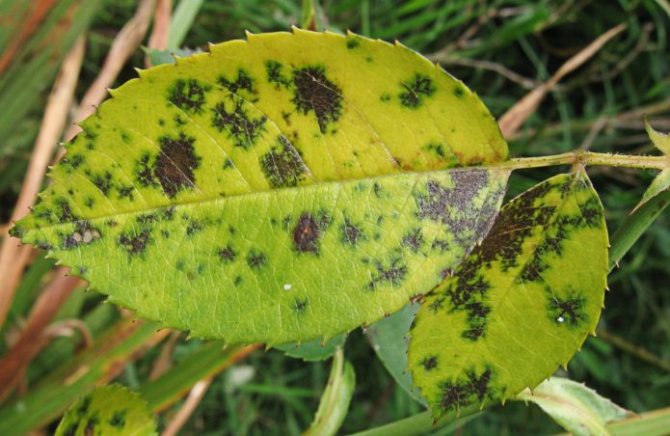

Black spot strongly weakens the rose and can lead to its death.
When the whole bush is affected by the disease, use HOM and Oxyhom. You will need at least 3 treatments once a week in wet weather or once every 2 weeks in dry weather.
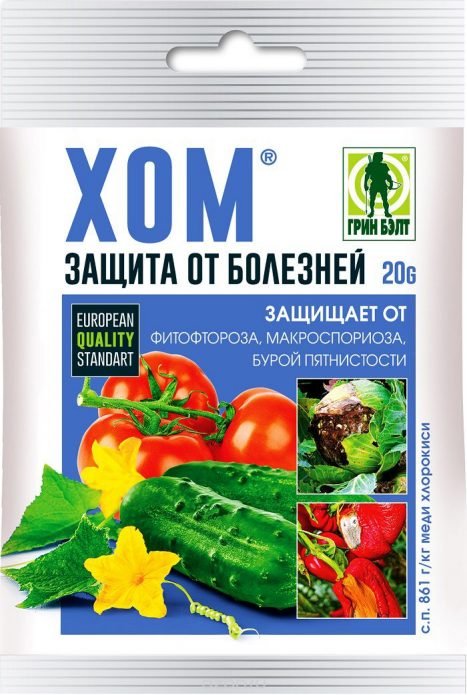

HOM - copper oxychloride, a popular remedy for all diseases of garden and horticultural crops
Fungicide Topsin is alternated with Strobi for the treatment of rose rust. The preparations are diluted according to the instructions and the bushes are sprayed three times every 10 days.
A completely rusty rose will most likely have no cure. It is better to burn it so as not to infect the entire rose garden.
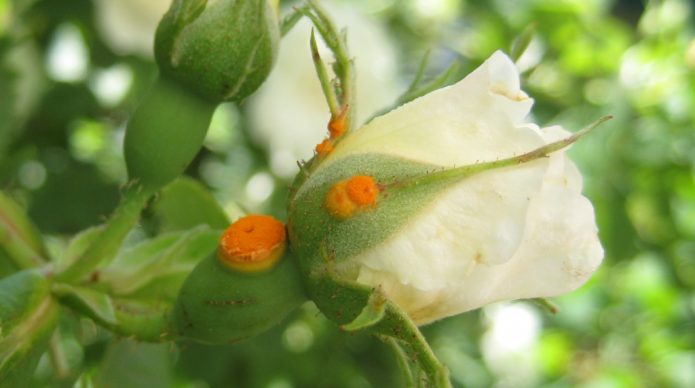

Rust is easily identified by the bright orange pads of the spores.
Folk remedies
Unfortunately, fungi that have settled on the leaves are poorly treated with homemade preparations. They are effective only as a preventive measure or in the early stages of disease development. The best product is prepared with wood ash. It must be infused with water for 2 days: 1 kg of substance per 10-liter bucket. To improve adhesion, add 1 tbsp. l. rubbed soap. It will take 2-3 treatments with a filtered solution once a week. Ash is also sprinkled on the ground around the bushes, and so that it does not scatter from the wind, it is slightly embedded in the soil. This technique allows you to make the environment around the rose more alkaline, and mushrooms prefer acidic and do not grow where they are uncomfortable.


Ash nourishes roses with phosphorus and potassium and protects against diseases
At the first sign of rust, milkweed infusion helps. It is necessary to grind 1.5 kg of stems and insist them in water in a warm place for 24 hours. Usually, two sprays are enough at intervals of a week.
The advantages of using "Topaz" at their summer cottage
As you have seen, "Topaz" belongs to fungicides with a very wide range of applications. Even despite the fact that today on the market you can find many analogues of "Topaz", the choice should be given to this particular drug, since it differs in a number of advantages:
- "Topaz" is exactly the chemical that has a long period of exposure to spores of fungal diseases. Thanks to this, preventive spraying can be done only twice a month, reducing the pesticide load on plants and soil.
- Instant absorption of the drug by plants allows you to stop the growth of fungal spores within 2-3 hours after treatment.
- The rate of use of the drug is very low, so one sachet is enough for almost the entire season, even if its use is necessary both in the garden and in the garden.
- "Topaz", unlike other preparations, can be used for a very large number of plants.
- "Topaz" is used practically at all stages of the growing season of plants: from the beginning of growth to the beginning of fruit formation. Even when ripe fruits get on, the toxic effect of the drug remains minimal, which allows them to be eaten without fear of poisoning.
- "Topaz" is compatible with many other preparations, which allows it to be used for complex plant treatments.
Late autumn processing of roses before shelter
In order not to grieve about the roses that died from an infectious burn and about chlorosis in the summer, it is necessary to treat them with iron sulfate before hilling and sheltering the bushes for the winter.
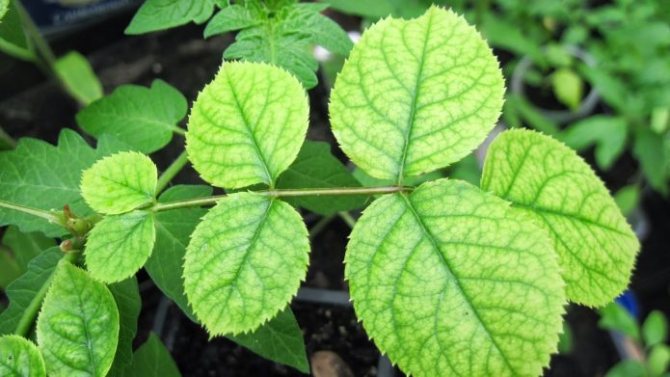

Chlorosis of roses occurs due to iron deficiency
Preparation of a three percent solution of ferrous sulfate:
- Dissolve 300 g of ferrous sulfate in 1 liter of soft or rain water. Use only non-metallic cookware.
- Pour the solution into a plastic bucket with 9 liters of water in a thin stream, stir.
Note that iron will precipitate in hard water. The bush itself and the ground under it are sprayed. After treatment with this fungicide, the leaves will turn black, this is normal. But it is guaranteed that not a single pathogen will survive until spring. But ideally, all tops should be trimmed and burned before spraying.
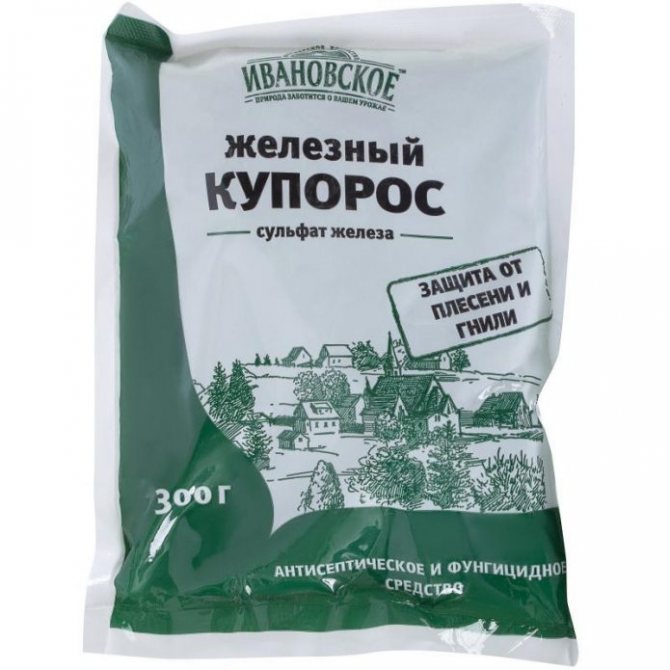

Iron vitriol is an old proven remedy that is safe for plants
For rose diseases, I alternately use the fungicides Skor and Ridomil Gold. Thus, it is possible to stop the spread of fungi. For prophylaxis, at the end of June I spray both roses and tomatoes with HOM. It is very convenient if you prepare 10 liters of solution, enough for both.
At first, I covered roses for the winter without treatments with iron vitriol. I noticed that even under a ventilated shelter - lutrasil, the bushes suffer from mold and an infectious burn. Therefore, I believe that it is imperative to spray roses with iron sulfate before frost.
Autumn diseases of roses are suppressed by spraying with fungicides and potassium-phosphorus dressings. If only a few leaves are affected, folk remedies will do. For beginners, so as not to get confused, it is better to use HOM for prevention and treatment. Winter health of thorny pets is guaranteed by treatment with iron vitriol. It burns out any fungi and spores.
Many gardeners limit watering and feeding, thinking that this is all the care of roses in the fall. Is this position correct? Do rose bushes need special care in autumn? Today we decided to answer these questions and talk about the main rules of autumn rose garden care.
Fungicide "Topaz": compatibility with other drugs
The compatibility of the Topaz chemical with other chemicals may not be spelled out in its instructions for use, however, for the comprehensive prevention of various plant diseases, this has to be done regularly. For this purpose, the preparation "Topaz" for plants can be mixed with such agents as:
- "Cuprosat", which allows you to fight late blight and circosporosis;
- Topsin-M, which is used against scab, moniliosis, gray rot, anthracnose;
- "Kinmix" - a drug for the control of larvae of pests of agricultural crops;
- "Horus", used for the prevention and treatment of Alternaria, fruit rot, clotterosporia, coccomycosis.
All of these drugs are fungicides, but differ from each other in the active substance. Due to this, when combining drugs, it is not necessary to reduce the doses, but you can use them according to the instructions.
What is the difference between autumn rose care?
Spring and summer care for roses is aimed at the active growth and development of plants. Autumn care, on the contrary, provides for the inhibition of their vegetation. Why is this necessary? Roses in the fall change their state somewhat:
- Stem lignification occurs;
- Shoots and buds slow down development;
- The root accumulates nutrition and strengthens;
- All metabolic processes slow down.
This is how nature prepares rose bushes for frost. How to properly care for roses in the fall? Let's figure it out.
Is it possible to spray roses
Since ancient times, it has been known how to spray roses: a tablespoon of baking soda was diluted in a glass of water and shrubs were sprayed five times a season. Also, according to the folk method, infusions of ash or mullein were made in a ratio of 1:20, which were used every week both for prophylactic purposes against fungal pathogens of flower diseases, and in the form of outside root feeding. At the moment, there are many chemicals than to spray roses to prevent various diseases and insect pests, but they must be alternated, as pathogens can become resistant to medicinal chemicals over time.
Features of autumn dressing and watering
Watering in the fall should be reduced, and from the end of September it should be stopped altogether. So we will stop the activity of roses and start the natural process of preparing bushes for winter dormancy. If autumn is rainy, then the rose garden must be protected from excess moisture. To do this, stretch a film over the bushes and make grooves around the flower garden to drain water.
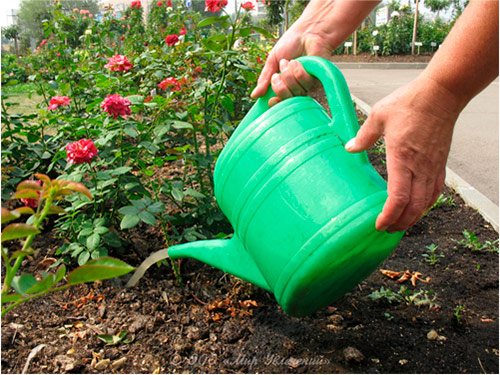

In the fall, you need to radically change the composition of fertilizers for roses. Nitrogen fertilizers are used only during the active growing season, they stimulate the growth of stems and leaves. We don't need it now. Strengthening the root is the main purpose of the autumn dressing of rose bushes. For this, our roses need potassium, phosphorus and magnesia. You can use fertilizers in granules, which are scattered on the surface of the loose soil under the rose bushes.
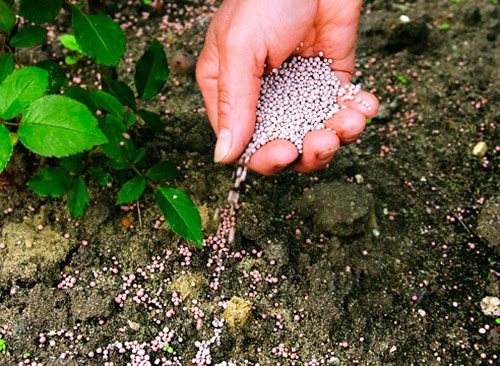

Expert advice
- Black spot can attack roses from rose hips growing nearby the site. If possible, transplant them as far as possible.
- Remove varieties from the garden that get sick much earlier and more severely than others suffering from black spot.
- According to many experienced flower growers, at least two actions must be strictly performed: spring spraying and removal of all foliage from the bushes and under them before sheltering for the winter. The result from the execution is felt immediately.
- Not a single variety possesses absolute immunity to disease. Therefore, they are divided into "susceptible" and "less susceptible." In general, modern hybrid varieties are more resistant to black spot.
- Prevention is of great importance. A variety that is resistant to black spot will hurt more often if not cared for properly. At the same time, due to the observance of preventive measures, it is possible to increase the resistance of the "susceptible" variety to the fungus.
Best neighbors for roses
Some growers like to plant some plants next to roses, but a lot depends on the climate and type of soil.
"Neighbors" will not cure black spot, but to a certain extent the bushes will protect against some diseases and pests that emit sweet honeydew (aphids, thrips, etc.), on which a sooty fungus sits.
Other gardeners have not noticed the beneficial effect in their experience, and note the inconvenience of planting and controlling the spread of such plants.
Lemon catnip, Lavender, Tagetis "Grunt-control", but you can also flowering varieties, Oak sage.
ADDITIONS TO THE ARTICLE:
We wish you to encounter and fight black spot of roses as little as possible!
How to feed roses in autumn?
Top dressing can be done in three ways: dry fertilizer, poured under the root; liquid fertilizer for irrigation; liquid fertilizer for spraying the aboveground part of the bush.
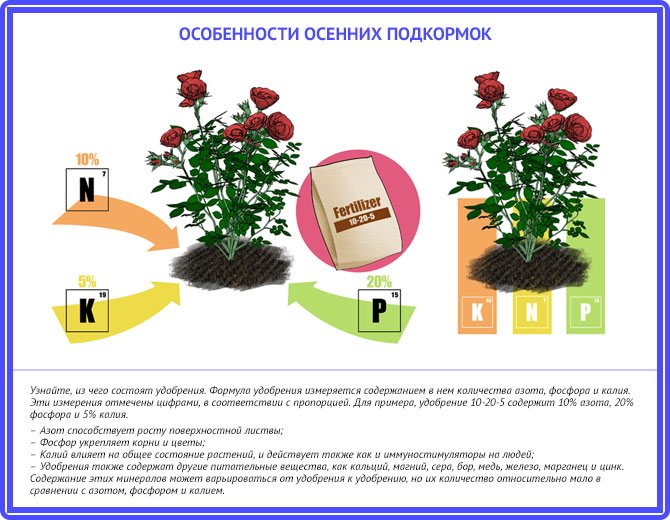

I. Fertilizer for irrigation
A tablespoon of potassium sulfate, 2 tablespoons of phosphate and half a teaspoon of boric acid are added to a bucket of water. This solution can be watered roses 2 times in the fall - in early and late September, and in cold regions - in late August and early September.
II. Spraying compound
For 30 liters of water, you need to take a tablespoon of potassium monophosphate and superphosphate. This solution should be used to irrigate the bush every 3-4 weeks until mid-October.
III. Dry dressing
There are two folk remedies that gardeners use today for flowers and horticultural crops in the fall. These are wood ash (sources of phosphorus and potassium) and powdered banana peel. Ash is diluted in water or sprinkled with dry powder on the ground. The banana peel is dry crushed and dug under the roses with the ground. You can bury fresh banana peels under the root, but this should only be done at the beginning of autumn so that the fertilizer has time to overheat.
Such funds can be combined, but the main thing should be remembered - the last feeding should be done no later than the beginning of October (or mid-September in a cold climate). The last means of nutrition, along with disinfection, is potassium magnesium in granules. It can be scattered over the surface of the soil before hiding the roses in October or November.
Preparations for the treatment of black spot on roses
To cure the disease, you need to use special drugs (fungicides) that suppress the development of the fungus. Next to the name of the funds, we indicate the active substance, hazard class, approximate price and its application.
Copper fungicides
"Abiga-Peak" (3, copper oxychloride)
Price: 75 g (bottle) - 99 rubles. Application: 40-50 g per 10 liters of water. Maximum of two sprays.
"Bordeaux mixture" (2, copper sulfate)
Price: 100 ml - 119 rubles. A proven drug for treatment, but it is better to use it in the event of an active and massive spread of the disease, since it is very toxic. Affected leaves do not regain their original color, but young leaves that have grown by autumn look good.
Application during the growing season: 10 g of substance + 10 g of lime per 10 liters of water (1% solution). No more than two treatments every 7-12 days.
Attention! Apply copper preparations sparingly to avoid creating an excess of copper in the ground.
Systemic fungicides
Previkur Energy (3, propamocarb hydrochloride, aluminum fosethyl)
Price: 20 ml - 180 rubles, 60 ml - 355 rubles. Spraying application: Dissolve 1.5 ml with 200 ml of water and then add 800 ml. For soil spillage: 15 ml per 10 liters of water at intervals of 14 days for up to five treatments.
"Skor" (3, difenoconazole)
Price: 2 ml - 53 rubles, 2 * 2 ml - 98 rubles. Application: 2 ml per 10 liters of water, maximum - three treatments every 7-8 days.
Domestic analogue - "Raek" (3, difenoconazole in the same concentration). Price: 2 ml - 29 rubles, 10 ml - 69 rubles.
"Topaz" (3, penconazole)
Price: 2 ml - 32 rubles. An effective and well-known drug with a powerful healing effect. Application: 4 ml per 5 liters of water, no more than three treatments every 7-10 days.
Fundazol (2, 3, benomyl)
A very popular fungicide. It is officially produced in packs of 5, 10 and 20 kg, but there is also a manual packing: 10 g - 60-80 rubles.
Application. Sprinkle roses with a solution of 10 grams per 10 liters of water. Maximum four treatments per season every 7-20 days, depending on the mass of the lesion.
- Attention! A very toxic product. Take 1-2 years off the drug.
Other popular drugs: Bayleton (3, triadimefon. Minimum package - 1 kg), Topsin-M (2, methyl thiophanate, hard to buy in a small package).
Systemic contact fungicides
Ordan (3, cymoxanil + copper oxychloride)
Price: 25 gr - 45 rubles. Application: 25 g per 10 l of water. Maximum of three sprays per season every 7-14 days.
"Profit Gold" (3, famoxadon and cymoxanil)
Price: 3 gr - 42 rubles, 6 gr - 75 rubles. Application: 4 grams per 10 liters of water, every 8-12 days. Maximum three treatments.
Other popular drugs: Ridomil Gold MC (2, mancozeb, mefenoxam. Packaging - 1 kg).
- Prices based on hypermarkets "Leroy Merlin", "Obi", etc., rate 1 dollar = 60 rubles.
Important! When working with chemicals, follow the manufacturer's instructions and be sure to use personal protective equipment.
Which is the best fungicide to choose?
To fight black spot on roses as efficiently as possible, it is necessary to alternate contact and systemic drugs, as well as systemic ones with different active substances, so that the fungus does not have time to adapt to them.
We recommend starting the fight with the least toxic agents (3rd or 4th hazard class). The choice of fungicide depends on what means you are treating roses for prophylaxis in spring, summer and autumn, and whether you spray at all.
We have named proven drugs for the treatment of black spot on roses, and then you try this or that fungicide and see the result.
Preparations for prophylaxis
"Copper sulfate" (3, copper sulfate)
Price: 100 gr - 26 rubles. Proven agent with powerful fungicidal action. It is allowed to spray the bushes only once a year. Therefore, it is better to treat roses with copper sulfate in the spring, before bud break or in late autumn. Application. 50 grams of substance per liter of water.
"Stroby" (3, kresoxim-methyl)
Price: 200 gr - 2850 rubles. Spraying does not guarantee the complete absence of black spot, nevertheless, individual affected leaves may appear, but there will definitely not be a mass infection.
Systemic treatments are required in May exactly every 10 days: 1. 10 g of substance per 10 liters of water, 2. 5 g / 10 l, 3. 2.5 g / 10 l. It is better to apply after, but it is possible two years after one (a remedy with another active substance - not from the class of strobilurins).
"Fitosporin M"
Price: 10 g - 20 rubles, 200 g - 65 rubles. Biofungicide, regular spraying from May to autumn, especially important in August. The main rule: if you start splashing, then continue every week. If the schedule is violated (no time, rain), then the probability of infection is high.
When black spots appear, there is no point in processing further, go to drugs for treating the disease. Buy only fresh preparation and it is better to buy a paste in a briquette (flat cake), not a concentrate solution. The effectiveness of "Fitosporin" increases in combination with the paste "Gumi".
Hom (3, copper oxychloride)
Price: 20 g - 35 rubles, 40 g - 49 rubles. Application: 30-40 grams per 10 liters of water. Spraying before and after flowering.
Folk remedies
It is better to use folk remedies for prevention, since they will not be able to cure black spot of roses with their help in 99.99% of cases.
Iodine
A proven prophylactic agent that suppresses various types of fungus. Application: dilute 1 ml of iodine in 400 ml of water.
Mullein
Dilute mullein 1 in 10 with water and leave for several days. Then water the entire bush liberally after removing the winter shelter. Infusion of mullein can be poured over the plant before bud break.
It is actively used by many growers who are engaged in the cultivation of market roses. The buds are not scalded, the fungus is suppressed and at the same time an excellent feeding is obtained.
Also, rose growers douse the bushes 2-3 times from May to July for prevention: the infusion is 1 to 10, and then it is diluted with water for another 1 to 10.
Onion and garlic husks
According to rose growers, the effectiveness of the husk decoction is higher than the infusion. Also, onion and garlic husks can be used as mulch under a bush to repel mice.
Pour a large handful of husks (30-40 g) with water and bring to a boil. Then leave for 6-8 hours. Spray the bush liberally and spill the soil underneath. After blooming flowers, just water at the root and slightly moisten the leaves so that the petals do not stain.
Ineffective funds
Wood ash. A popular and very useful substance, but unfortunately ineffective in the case of spotting on roses.It is advisable to use wood ash for soil mulching in July - August, as a natural potash fertilizer.
Herbal infusions (nettle, horsetail, etc.). It is often recommended, but the effectiveness is close to zero.
Citrus. Decoction and infusions of citrus fruit peel, in any ratio, method of preparation and use. The result is 0.
Alirin and Gamair. Good preparations, but, according to gardeners' reviews, it is black spot that often appears after preventive spraying. Some rose growers share their successful application experience so that everything is individual.
"Glyocladin". It is for rose diseases that there is no effect. A must-have for preventing root rot in phlox and peonies.
How to carry out preventive measures in the fall?
Autumn is a period of active reproduction of pathogenic bacteria and rot. Pests are looking for wintering places, which are often the stems and leaves of roses. Flowers during this period are especially vulnerable, since they have already given all their strength to growth and flowering, so they need the following preventive measures:
- Regular cleansing of the soil around the bushes.
It is necessary to remove weeds, fallen leaves and other debris, since all this, rotting, can infect the roots and trunk of plants; - Pruning the lower leaves and shoots.
The lower leaves and shoots are the first to be affected by diseases, so they must be completely removed from the middle of September (at least 30 cm from the root); - Treatment.
After cleansing and removing the leaves, the stems of the roses are treated with fungicides or a disinfecting solution of manganese, soda. You can buy a ready-made disinfectant for autumn processing in a specialized store.
Fundazol
Benomyl-based drug belonging to the class of benzimidazoles. Available as a white powder. Possesses high toxicity. Getting on plants stops the division of cells of fungi, causative agents of various diseases. Plant treatment takes place in the first three days. The protective effect lasts for another 4 days.
IMPORTANT: In addition to the positive effect on fungi, it can destroy aphids, leaf beetle larvae and spider mites.
- Effective over a wide temperature range
- Can be used for autumn processing of plants
- Possesses extremely high toxicity
- In case of an overdose, it inhibits the plant and can lead to its death
How to prune roses for the winter?
Even from the beginning of September, you need to control the abundance of flowering roses. All buds should be bent down at the base. This way they will not develop. If you cut them off, then you can provoke the growth of new buds and shoots:
Pruning roses for the winter is a must-have autumn event for all varieties. But each variety requires a different approach. So, for weaving roses, pruning can consist in pinching the growth points, and bush and species varieties need to be cut thoroughly.
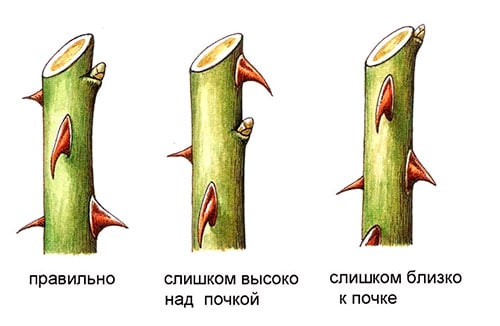

Roses are pruned 1-2 weeks before hiding. From the beginning of September, it is necessary to cut off all affected stems, not fallen leaves, young shoots and buds. In front of the shelter itself, 3-5 strong stems are left, cutting off the top to lignified areas.
Tips from experienced florists
To prevent all of the above ailments of the southern beauty, experienced flower growers and summer residents recommend, first of all, to maintain ideal cleanliness on the land plots planted with flowers, timely remove and burn fallen affected foliage, cut off infected areas of stems and inflorescences, increase the immunity of plants by spraying and watering with the necessary fertilizers.
When planting flowers, keep a sufficient distance for airing. Provide protection against rodents and pests.
Observing all the rules for caring for plants, a blooming garden will delight as long as possible.
Learn how to deal with black spot on roses. We describe the treatment (control measures and how to treat the flowers to get rid of the disease).
We name the best drugs and remedies for black spot, as well as expert recommendations and prevention.
Transplanting rose bushes
September-early October is the best time to transplant roses. The first in line for a change of residence should be weak roses that did not respond well to care during the entire growth period. For new residents of your rose garden, it is also better to find suitable places in the fall:
The process of transplanting roses is as follows:
- Choosing a sunny, open space for flowers;
- Layout and preparation of holes for planting. Miniature roses can be planted denser (40-50 cm between bushes), climbing and bush varieties require sparse plantings - 1-1.5 meters. The standard size of the holes is 50x50 cm.;
- Preparation of nutritious soil mixture. Peat, sand and compost are taken in equal proportions. The soil for roses can be diluted with clay. Ash, bone meal and other nutritional components are added to the finished mixture;
- Planting seedlings. The pre-soaked seedlings are dipped into the holes by the roots, the root must be straightened. The bush is covered with earth and watered thoroughly. When the water is absorbed, young roses need to be piled up.
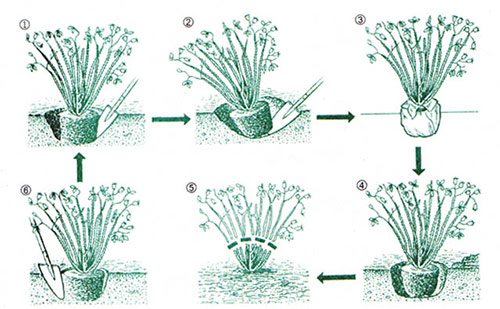

Serious mistakes gardeners make when using fungicides
- Using the same chemical fungicide in reprocessing.
Many drugs cause resistance. The alternation of systemic agents, with contact substances, or their simultaneous use in tank mixtures will help to avoid it.
- Surface spraying of roses with contact fungicides.
When treating bushes, it is important to treat the shoots and leaves from all sides. Many pathogens travel upward from the ground and settle on the underside of leaves. If you apply the solution only to the outer part of the crown, the drug will not get on pathogens, which means that spraying will not work.
Rate the quality of the article. Your opinion is important to us:
Rose care in September
At this stage, you must adhere to the following rules:
- We stop cutting the rose into bouquets, as this stimulates the growth of new buds. In young roses, which you did not allow to bloom in the summer, you need to leave the last inflorescences and let them ripen;
- Reduce watering. If September is hot and dry, then you can water the roses once a week until the middle of the month. After watering, we produce it once every 2 weeks and completely stop watering the rose garden by the end of September;
- We are replacing growth-stimulating nitrogen fertilizers with potassium-phosphorus fertilizers. This will strengthen the root, and the plant will better survive the cold. Often we do not feed the roses, it is enough to make two dressings.
Your actions this month:
I. Top dressing of roots with potassium-phosphate composition
You can scatter dry granules near the roots and lightly tamp them into the soil, or you can prepare a slurry (see tips above) to water or spray the green part of the roses.
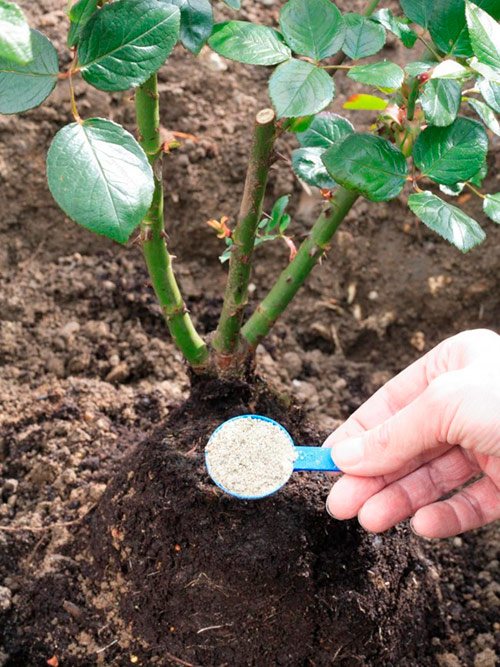

II. Last loosening of the soil
It is better to produce it immediately after feeding the bushes. This can ripen the last rosebuds faster.
III. Limited watering
Ideally, roses should be watered in September 2 times - at the beginning and towards the end of the month. If September is not dry, then you do not need to water the rose garden additionally.
IV. Weeding weed
All young weeds should be removed from the rose garden. They can become a source of infection.
V. Removing the bottom foliage of roses
Leaves are also often infected with infections, moreover, their presence can stimulate photosynthesis and prevent the rose from slowing down metabolic processes. All leaves up to a height of 20-30 cm must be removed.
Vi. Stalk processing
After removing the foliage, the bare stems need to be painted with garden varnish, water-based solution or other disinfectants. This will protect the bushes from rot and pests that are looking for a place for the winter in the stems of plants.
Prevention: how to prevent illness?
Strong and healthy plants have great resistance to fungus, so you need to properly care for the flowers.
In preventive actions, consistency, timeliness and an integrated approach play an important role, and it is also better when they are carried out throughout the entire site, and not just rose gardens.
- Plant in a sunny location. There should be enough space between them, because with excessive planting density, moisture slowly evaporates and it is easier for black spot to move from one flower to another.
- Timely and correctly prune the plant in the spring (sanitary and formative), process the cuts with crushed charcoal.
- The likelihood of being affected by the disease increases an excess of nitrogen fertilizers (feed only until the first half of summer) and a lack of potash. Feed regularly with potassium (potassium sulfate, potassium salt, wood ash) from spring to autumn. Mandatory feeding: late May - early June and late July - mid August.
- Water and fertilize with liquid fertilizers only at the root. Do not water in the evening and at night.
- Enrichment of the land under the bushes with beneficial bacteria. Mulch with cut grass, add compost or rotted manure, use the biofungicide Fitosporni-M (spraying, watering the soil).
Treatment of roses in spring from black spot
To prevent the onset and development of the disease, it is important to process roses after winter.
- Immediately after opening in the spring (before bud break), spray the flower and the ground under it with a 2-3% solution of Bordeaux liquid (220-250 g per ten liters) or a 3% solution of copper or iron sulfate (300 g per ten liters). Alternate the remedies every spring.
- At the beginning of leaf blooming (temperature above +10 ° C), spray roses with copper-containing preparations or Strobi treatment according to the system described in the section "Prevention preparations".
- If you do not want to use chemicals, then at temperatures above +10 ° C, treat with biological (Baikal Em-1, Gumistar, Fitosporin-M) or folk remedies (iodine, onion peel decoction, mullein infusion) every 6 -12 days.
Summer
Remove weeds and fallen leaves regularly, inspect flowers and apply top dressing. Spray from June to September with growth stimulants and strengthening the immune system ("Zircon", "Epin - Extra").
"Zircon". Reliable formulation, proven to be effective on many types of plants. Spraying with this agent increases the density of the leaf plate, promotes the growth of green mass and strengthens the plant's immunity.
Fall
- In September, feed the plant with potassium-phosphorus fertilizer (40 grams of potassium salt and superphosphate per 10 liters of water).
- Before you cover for the winter, be sure to cut off all the leaves on the bush, collect and take out, or burn the fallen leaves.
- Then treat the flower and the ground near it with copper-containing preparations: a 3% solution of iron (preferable) or copper sulfate.
Rose garden care in October
The features of this stage are as follows:
- We stop loosening the soil under the roses in order to slow down the access of oxygen to the roots;
- We stop watering roses and feeding;
- If October is rainy, then the rose garden needs to be covered with a film and water is drained from the roots;
- At this stage, disease prevention is required - spraying and cleaning the bushes.
You need to follow these steps:
- Spraying bushes with 1% Bordeaux liquid. This will rid the stems of bacteria and pests;
- Tear off all foliage and fold over unripe buds. You do not need to cut the buds yet, this can provoke the release of new inflorescences, especially if October is warm;
- Cutting the roses. Shrub, miniature and thermophilic roses should be shortened to the height of insulation. Climbing and standard varieties must be pinched at the point of growth, removed from the support and laid on the ground;
- We transplant roses that did not grow well this season, or we plant new varieties for the rose garden.
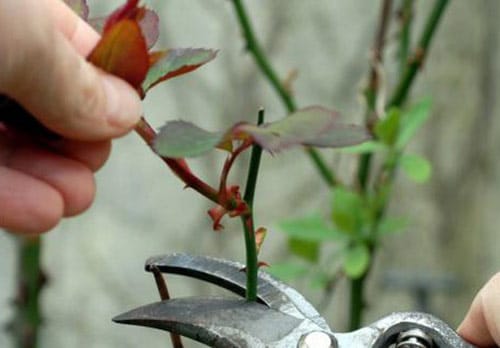

Baktofit
Biological fungicide based on Bacillus subtilis strain IPM 215. Available in powder and suspension form.After entering the plant, the bacteria produce an antibiotic that suppresses the activity of pathogenic fungi.
- Environmentally friendly compared to chemicals
- Highly effective in rainy weather
- Low toxicity (class 4)
- Efficiency is 60% -70%, can only be used for prevention
- In dry weather, the effect deteriorates
Safety engineering
Fungicidal drugs require compliance with the rules:
- when spraying, they work in protective overalls, a mask, gloves;
- use separate containers, which are then disposed of or removed for subsequent use;
- exclude contact with food;
- in case of accidental contact with Topaz on the skin, the integuments are washed with plenty of clean water;
- if the product or working solution gets on the face, thoroughly rinse the eyes, skin, rinse the mouth;
- with a slight poisoning and penetration of the fungicide inside, take activated charcoal with a large amount of water. Gastric lavage helps, after which they must consult a doctor;
- the used ampoules and containers from the suspension are disposed of.
Safety measures when using the drug "Topaz"
The preparation for processing plants "Topaz" is a chemical substance, direct contact with which can result in unpleasant consequences for a person. In this regard, when using it, it is important to adhere to the following rules:
- It is recommended to prepare a solution from a chemical in a container that will not subsequently be used for cooking food either for humans or animals.
- During the treatment of plants, vapors should not be inhaled, for which it is important to use a respirator. Hands and body should also be covered with protective clothing. Try to make sure that pets cannot come into contact with the substance either.
- In case of accidental contact with the hands or face, the remedy for plant diseases "Topaz" is important to thoroughly wash off with soap. It is also recommended to rinse your mouth out.
- In case of mild poisoning with Topaz vapors, take a few tablets of activated charcoal and drink a couple of glasses of water. If drops of solution with the drug got into the stomach, perform gastric lavage.
- Do not smoke, drink or eat while handling the drug.
- In case of contact with eyes, rinse immediately with running water.
Thus, regardless of whether you have a vegetable garden or only flowers on the windowsill, Topaz will always help you out. After all, it is recommended to use it not so much for the direct treatment of plants as for the prevention of common fungal diseases.
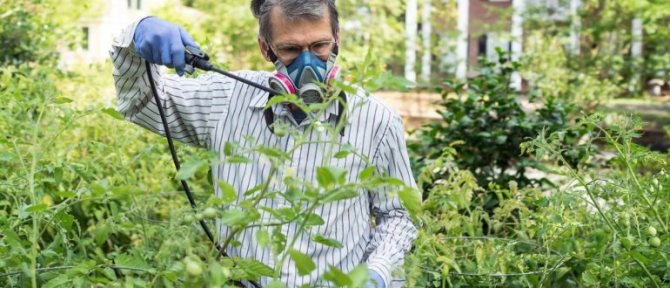

Mycosis diseases most often affect cultivated plants. The fungus chooses for its habitation not only the inhabitants of the garden and vegetable garden, but also indoor flowers. Aggressive phytopathogen oppresses and destroys the culture in a short time. For the protection and treatment of garden, garden and home plantings, special agents from the category of fungicides are used. In practice, Topaz has proven its effectiveness - a drug for treating plants from fungal parasites. Like any other agrochemical, the substance has its own characteristics that you should be aware of before using.
Scope of use
Fungicide, based on the instructions for use, has a wide spectrum of action. The spreading rate is high, which gives the plant quick relief from damage:
- septoria and powdery mildew;
- purple spot and fruit rot;
- scab and rust;
- gray rot and powdery mildew.
These diseases are more terrible for roses, carnations, pot or garden plants. As for oidium, the disease occurs on grapes, in every third vineyard. And rot loves to settle on peaches. For conifers, Topaz will also benefit.
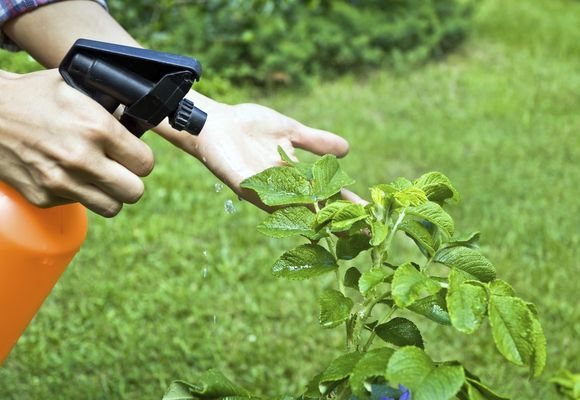

Although these diseases are not often found on them.It is enough to process completely the land holdings and forget about the problems for a long period of time. Not afraid of rain, moisture. It is permissible to engage in spraying of the fungicide at any time of the day.
Need to know! Despite the permission to use Topaz at any time, in any weather, seasoned gardeners claim: spraying will be more beneficial when applied to the plant in the early hours. It is advisable to do the procedure in calm weather, but not sunny.
Preparation of "Topaz" working solution
It is very easy to prepare a working fluid from an emulsion concentrate. The main thing is to stir the drug well in water, remembering that it does not dissolve, but a dispersed system is formed.
To prepare "Topaz" for work, non-chlorinated water at room temperature is required. According to the instructions, the required amount of the drug is measured and poured into the water. After that, within 3-5 minutes, the liquid is vigorously shaken or stirred.
Tip # 1. "Topaz" forms a fairly stable emulsion, but the working fluid should not be stored for a long time. After preparation, it must be used within 1-2 hours. When processing, it is advisable to shake the sprayer from time to time.
Operating principle
The drug Topaz has the necessary effects due to the active substance - penconazole. When diluted, the concentration of the substance is 100 g per liter. The insecticide quickly enters the body of the fungus that has appeared on the plant. Then it helps to slow down development. Leads to complete destruction.
It dissolves well when it gets into a liquid. Not afraid of acids and alkalis. The active ingredient does not give a chemical reaction when combined with them. The main component (penconazole) is absorbed quickly and well into all parts of the plant:
- leaves;
- sprouts;
- shoots;
- flowers
Description
As already mentioned, the Gold Topaz Rose belongs to the hybrid tea group. It has a subtle, subtle sweet aroma.
The bush of the plant is strong, dense, fast-growing, its height is 70 - 100 cm. The stems are erect, even, dense, thick. They are tough and have thorns. The leaves are dark green, large, glossy.
The flowers are large, goblet, elongated, double (35 - 40 petals). Bud height (13 cm), width (12 cm). Formed on one peduncle 1 - 3 buds. The petals are dense, leathery. They are painted in bright pink, sometimes lilac, purple shades, outside they have blurry white tones in the form of strokes at the bases.
Important! Flowers stay on the bushes for a long time, and then stand in cut for quite a long time (at least 15 days).
How to process the aboveground part and soil
Treatment should be carried out by spraying in the fall, but since rose disease occurs regardless of the season, iron sulfate in small concentrations is used during the growing season.
Shoot processing in spring and summer is carried out according to the scheme:
- use a solution with a concentration of 1%;
- it is distributed over the leaves and shoots of the plant using a spray bottle;
- rose flowers are removed before processing;
- fallen leaves are collected and burned;
- the treatment is repeated 3 times every 10 days.
Processing scheme in autumn:
- carry out autumn pruning;
- remove fallen leaves;
- prepare a solution of 3% concentration and spray it with a rose;
- you can cover the bush for 3 days after manipulation, but no later than 14 days.
You can water the soil with vitriol before wintering the plant, because fungal spores can form from the soil. Be sure to spill the prepared mulch with the composition.
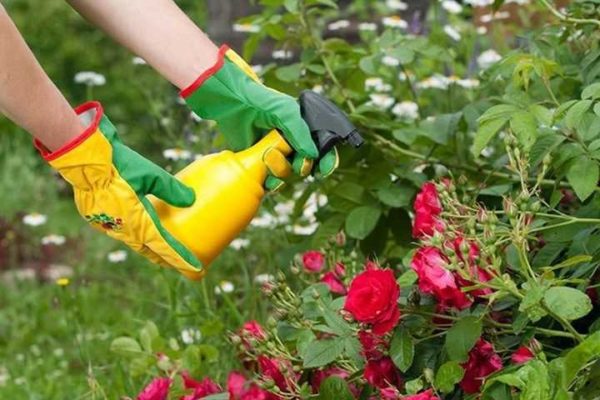

Comparison with other fungicides
Popular analogues of vitriol are considered in the comparative table:
| A drug | Description |
| Ridomil gold | A drug that is safe in relation to roses, which has not only a contact effect, but also penetrates the stem. The product is not washed off after rain, therefore it surpasses kuparos in efficiency due to its long-term effect. |
| Oxyhom | It is used to treat mycoses rosary at any time of the year. There are no strict contraindications for use during the flowering period. |
| Abiga peak | It is washed off with water, therefore it ceases to act after rain. Does not harm green mass. |
| Bordeaux mix | It is widely used in horticulture, but it is difficult to prepare a working mixture. |
Spraying in the spring
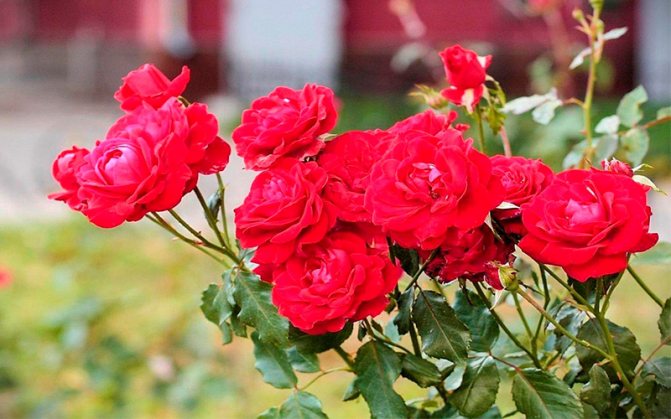

In the spring, spraying of rose bushes is done in two cases. The first is the desire to hedge against the fact that the autumn processing could not give the expected result. However, this can only happen in case of careless spraying.
The second, more common reason for spring processing is that for some reason you could not do it in the fall.
Spring spraying should be done before the buds begin to swell, when the outside temperature is above five degrees Celsius.
The concentration of vitriol in water for spring treatment should not exceed 1%. A mistake in the direction of increasing the dosage when diluting the drug is dangerous: the bushes may die.
What is copper sulfate: composition and form of release
Copper sulfate is otherwise called bivalent copper sulfate or copper sulfate (again, bivalent). The appearance of the product is blue small crystals (powder). It dissolves well in water.
It gained such distribution in everyday life due to its versatility and antiseptic properties. So, in construction, it can be used to process wood (to prevent rotting, neutralize the effects of leaks, eliminate rust stains, and also use it to remove salt emissions (so-called "efflorescence") from brick, concrete and plastered surfaces.
In addition, it is used for the manufacture of mineral paints, for removing rust stains on the ceiling after flooding, for detecting the presence of zinc, manganese and magnesium in aluminum alloys and stainless steel (in the presence of these metals, red spots appear), and, of course, copper sulfate is as wide as possible used in the garden and vegetable garden.
Gardeners reviews
Elena, 27 years old, Moscow region
I use Topaz fungicide to get rid of gooseberry and currant powdery mildew. I carry out the processing 2-3 times: in early spring, when the first leaves appear, during flowering and in autumn after harvesting the berries. The remedy is effective only if the plants are treated several times per season. An excellent drug against fungal diseases on shrubs.
Valery, 48 years old, Perm
Two years ago, powdery mildew struck the gooseberries, so they were left completely without a crop. Last year I decided to use chemicals to ensure that the berries are picked from the bush. When used correctly, Topaz helps to cope with the disease. In early spring, I processed gooseberries twice with an interval of 10 days. I diluted the Topaz fungicide emulsion with water according to the instructions. During the season, no signs of illness appeared.
Ekaterina, 36 years old, Voronezh
Powdery mildew appeared on the roses last year. To fight the disease, I decided to purchase Topaz. I processed the rose in the morning. Although it rained during the day, the fungicide began to take effect. During the week I watched the bushes, and did not find any new signs of the disease. After 10 days, the spraying was repeated. Gradually the rose comes to its senses and releases new leaves.
Storage period and rules
Store the drug at room temperature no more than 20 degrees. Storage conditions: dark place, out of reach of children and animals. It is advisable to isolate from sunlight, high temperatures, humidity. The permissible temperature is 30 degrees. Shelf life is 4 years from the date of issue.
It is not recommended to keep ampoules of the substance near food, dosage forms... Used ampoules are separately packed in an airtight container and thrown away from water bodies.
Answers to Usage Questions
There are peculiarities in the use of copper sulfate in gardening. The rules applied to horticultural crops are not applicable to roses. For example, to treat fruiting trees, 5% solutions are used in the spring, while such a concentration will simply kill the rose bush.
A solution of even small concentrations is harmful to the soft tissues of the plant, immature shoots and leaf mass, because blackening after processing is natural. We must wait for spring. And then remove the shelter and see what happens to the bush. If the roses have received a chemical burn, they are pruned to soft tissues, the sections are treated with crushed activated carbon. You can not wait for rapid growth and flowering in the coming season, the main task is to save a weakened bush, therefore, you need to abandon the use of fertilizers.
The use of copper sulfate in gardening (video)
The main purposes of using copper sulfate in the garden and vegetable garden:
- for whitewashing trees;
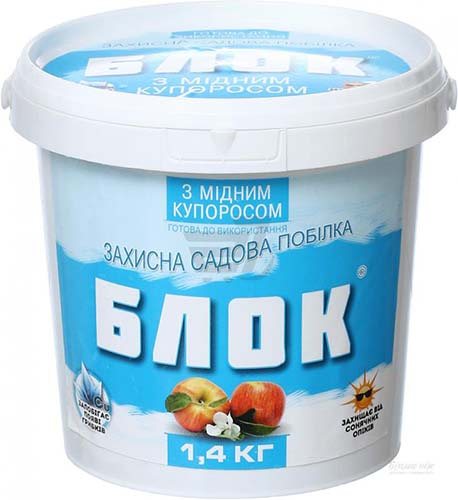

- By the way! Read about how to properly whitewash trees in autumn and spring in this article.
- for eradicating treatment (spring and autumn);
- for spring preventive treatments against fungal diseases (trees and shrubs);
- from late blight;
- disinfection of wounds (after pruning), cracks and hollows in trees (1% solution);
- for fertilization (replenishment of the copper deficiency in the soil);
- for disinfection of the roots of rose seedlings, berry bushes and fruit trees in order to prevent fungal diseases (immerse in a 1% solution for 3 minutes, and then rinse under running water);
- for spring and autumn greenhouse processing.
Copper sulfate and "Bordeaux mixture", which also includes copper sulfate or copper sulfate, has been used by gardeners and gardeners for more than a century as a highly effective and readily available chemical against plant parasites and pathogens. Copper sulfate is incapable of dusting and does not differ in volatility, but it must be diluted with all precautions and personal hygiene.
Reviews of the effectiveness of "Topaz" and anti-resistance model
An analysis of reviews of the Topaz fungicide among gardeners and winegrowers confirms the high effectiveness of this drug:
“In my opinion, nothing better than Topaz for powdery mildew has yet been invented. In our area, this infection has ceased to respond to treatment for the past few years. We used to treat her with Bordeaux liquid or "Oxychom" (see → how to apply the fungicide). Even folk remedies often helped. Then it, apparently, mutated, and now it turns out to be taken only with "Topaz" "(Natalya, Leningrad region).
When commenting on this review, it is important to emphasize that Topaz can also decrease its effectiveness over time if you use it permanently. To prevent the development of resistance in infectious agents, the principle of drug rotation must be observed. To do this, you can use different anti-resistance schemes. The following model works well for Topaz:
- first year - Topaz;
- second year - Oxyhom;
- third year - "Ampelomycin".
Then the scheme is repeated: "Topaz" - "Oxyhom" - "Ampelomycin". Thus, there is an alternation of drugs with different active substances, and the population of fungi does not have time to develop a defense mechanism.
Features of the drug
Fungicide Topaz is a chemical agent that belongs to the class of triazoles. Its action is based on penconazole, which inhibits the functioning of fungal spores. As a result, the spread of fungal spores stops.
After use, the substance does not form a film on the surface of leaves and shoots. The active substance penetrates the walls of plant cells.
Important! Topaz is effective in cold and rainy weather. The processing is carried out at a temperature above -10 ° C.
The product can be purchased in 2 ml ampoules or 1 liter plastic containers. Duration of storage of the drug is 4 years. An analogue is the drug Almaz.
Fungicide Topaz is used to combat the following diseases:
- powdery mildew;
- various types of rust on the leaves;
- oidium;
- gray rot;
- purple spot.
Topaz is compatible with many chemicals and prolongs the positive effect of their use. The alternation of fungicides improves the efficiency of the treatments.
Most often, Topaz is used in conjunction with the following drugs:
- Horus - to get rid of Alternaria and coccomycosis;
- Cuproxat - for the treatment of late blight and cercosporia;
- Kinmix - for pest control;
- Topsin-M - in the form of therapeutic measures when signs of anthracnose, scab, fruit rot appear.
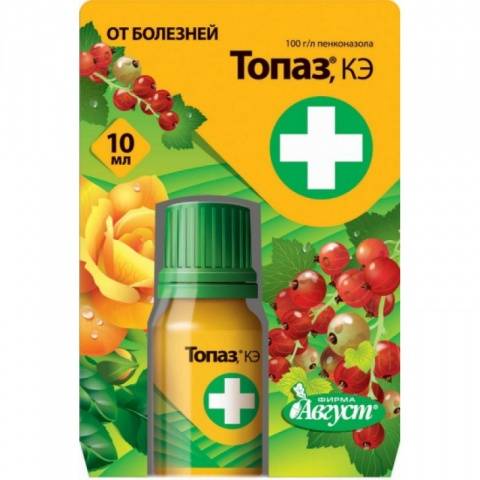

Advantages and disadvantages
Fungicide Topaz is a unique drug that has a lot of significant advantages:
- High speed of action and prolonged protection against infection.
- It is quickly absorbed by plant tissues, which eliminates the impact of external factors on its work.
- Suitable for a wide range of garden, indoor and garden plants.
- Does not possess phytotoxicity.
- It can be used at any phase of the life of a culture.
- When processing fruits, it does not affect their quality and safety for human health.
- Excellent compatibility with other agricultural products to enhance the effect.
- Cost-effective in spending.
- Approved for use in summer cottages and inside residential premises.
The obvious disadvantages of the drug include:
- the duration of disintegration (penconazole decomposes completely within 14 - 21 days),
- with long-term use (more than 3 years), the active substance can accumulate in the soil,
- does not give a result with a strong fungal infection,
- toxicity to some living organisms sensitive to the active substance.
Precautions
The toxicity of the substance is the third class. Refers to the temperate species. Safe after processing for living beings. But during the processing period, the animals must be kept at a distance (150 m) from the spray area.
People should be provided with protection of mucous membranes, skin. To do this, use a protective suit, elongated rubber gloves, glasses, a hat with a net.
Work to be carried out at a distance. During the period of application, do not drink liquids or smoke. It is also prohibited to handle near open fire, flammable objects.
The composition and characteristics of the fungicide
Means "Topaz" - the undisputed sales leader for the elimination of fungal diseases. It is used for plants growing in open and closed ground. Topaz is recommended for all types of crops on which powdery or downy mildew has appeared.
Preserves the maximum yield. As a prophylactic agent, Topaz is used in the garden. Helps prevent powdery mildew in vineyards, rust in garden flower beds.
The remedy for plant diseases has a preventive and therapeutic effect due to the presence of the main component - penconazole. The substance belongs to the fungicidal type.
A positive point is the ability of this fungicide to stop the multiplication of fungal spores after three hours after spraying. The main chemical component is active against:
- coccomycosis;
- blotches of purple;
- fruit rot;
- rust;
- powdery and downy mildew.
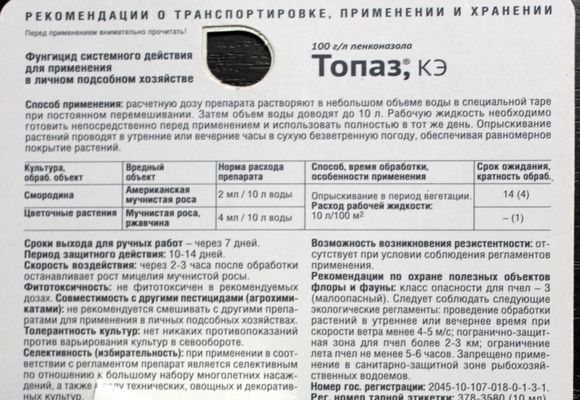

Instant defeat of fungal spores prevents the development of the disease, stops the result and activity of the fungus at all stages of development. The penetration of the substance is as fast as possible, which distinguishes Topaz from the already known fungicides. Plus, the remedy:
- not afraid of moisture and rain;
- temperature drops;
- it is distributed evenly over the infected plant, as it penetrates into the juice;
- provides protection for mature and developing shoots.
If you use Topaz as a prophylactic substance, as indicated in the instructions, this will provide a quick recovery and preservation of the plant, yield.But in order to achieve the set goals (treatment and prevention), it is necessary to follow the exact dosages, the scheme of use. The necessary information is described in the instructions for Topaz.
Mechanism of action
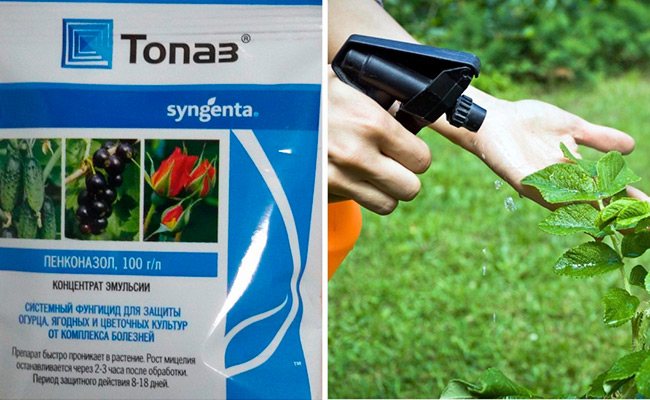

When it gets on the surface of leaves, stems, branches of plants and trees, the active substance of the drug penetrates deep into the interior. Penconazole affects the spores of the fungus (both forming and at the stage of germination), suppresses and prevents them from developing further. The substance actively interacts with the sap of plants, moves through the vessels, including into the growing shoots and shoots, protecting them from further spread of the pathogen.
Prescription of the drug Topaz
Agroperaparat Topaz is intended for the prevention and treatment of common fungal diseases of plants. Its action is aimed at oppression and elimination of the parasitic pathogen. The fungicide Topaz is effective against powdery mildew, various types of leaf rust, gray and fruit rot, purple spot, grape powdery mildew and American powdery mildew on currants.
The agricultural product is used to process a variety of crops:
- vegetable annuals,
- fruit trees,
- berry bushes,
- garden strawberries and strawberries,
- grapes,
- rosaceous,
- floral annuals and perennials,
- many types of indoor plants.
It is important to take into account that this remedy is effective only at the initial stage of infection; in case of severe infection with a fungus, it will not help.
Release form and composition
Topaz is a fungicidal pesticide. The active ingredient of the drug is penconazole. This substance is obtained by a chemical method, belongs to the group of triazoles and has the formula C13H15Cl2N3. The concentration of penconazole in the agro-product is 10% or 100 g per liter.
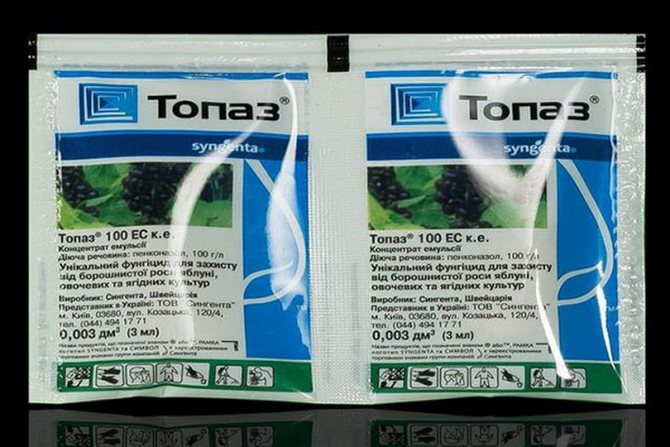

The developer of the fungicide is the Swiss corporation Syngenta. Green Belt is also produced on the Russian market under license from Topaz. The formulation is a concentrated emulsion packaged in 2 ml ampoules, 3 ml sachets or liter canisters.
Operating principle
After spraying, the active substance quickly enters the plant's body. Mixing with plant juice, it moves throughout the vascular system to leaves, shoots, flowers and fruits. The effect of Topaz is to disrupt the biological synthesis of mycotic sterols, due to which the growth of fungal spores, which have not yet had time to penetrate deeply into the plant's body, are inhibited.
Penconazole begins to act after 180 minutes after treatment. Since the drug works from the inside, its effectiveness is not affected by precipitation and a decrease in air temperature to -10C˚.
Terms of application
To achieve preventive goals, Topaz is applied in early spring as soon as the snow melts, or at the end of the season after harvesting the fruits, even at the time of the beginning of frost.
For treatment, a fungicidal agent is applied as needed when the first signs of the disease are detected from 2 to 4 times with a pause of 14 days. The main thing is that the last processing is carried out no later than a month before harvesting.
How can copper sulfate be used in gardening: spheres and methods
Water-soluble powdery crystalline substance with a characteristic blue-blue color. The active ingredient is represented by copper sulfate, the amount of which is 0.98 kg. A solution of the drug is used to protect and treat fungal infections on fruit and berry plantations. Processing of vegetables and flowering crops, including roses, is also carried out. The protective effect lasts for a month.
The mechanism of action consists in the reaction of copper ions and lipoprotein or enzymatic complexes of a fungal or bacterial damaging factor. The result of exposure is the appearance of irreversible changes in the protoplasm and nonspecific denaturation of protein compounds.Hazard class - 3, so the drug is moderately hazardous. Correct preparation is carried out in accordance with the instructions supplied by the manufacturer of the preparation.
The popular fungicidal agent is highly soluble in water and is widely used in the treatment of any garden and vegetable garden, as well as in indoor floriculture conditions. Spraying helps to cope with lesions presented by:
- alternaria;
- ascochitis;
- moniliosis;
- scab;
- grape mildew;
- spotted;
- septoria;
- downy mildew;
- rust
- late blight.
November works in the rose garden
The last and shortest stage of rose care is the beginning of November. During this period, fertilizing, watering, processing and any measures that can stimulate sap flow inside the plants are not carried out.
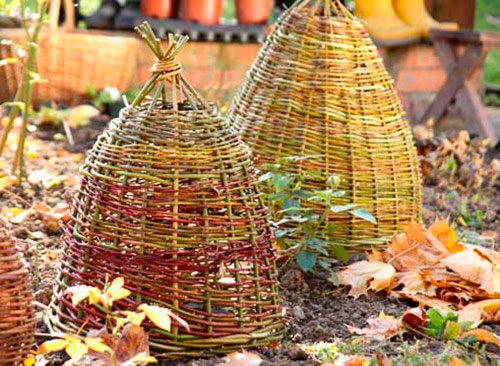

A week of consistently negative temperatures outside should be a signal for hiding roses for the winter, which consists of the following steps:
- Garbage collection, digging up the earth and hilling rose bushes to a height of 30 cm.If the roses were laid on the ground for the winter, then a hill 50 cm high is poured onto the root;
- Construction of a shelter for roses for the winter. This can be a bulk method, an air shelter, a frame method, etc. For more details about ways to shelter roses for the winter, read our other materials.
So, you can breathe easy. Autumn has come to an end. Your roses are securely covered and properly prepared for a successful winter. Now it remains to wait for spring, anticipating the grateful bloom of your rose garden pets.
Preventive treatment as an important part of preparing roses for winter
Before sheltering, roses and soil are treated with protective preparations.
How roses overwinter depends on their state of health, with which they will encounter a drop in temperature. If the entire vegetative period the bushes grew on rich soil, and were strong and strong, then they have much more chances to endure frosts than weak plants. Unfortunately, even a gardener who fertilizes roses correctly is not immune from their favorite diseases. The threat of infection exists everywhere, for example, on fruit trees or on wild rose hips behind a fence. No matter how disease-resistant your rose variety is, there is no 100% guarantee that it will cope with the infection on its own. That is why, twice a year in spring and autumn, it is necessary to spray the bushes with protective agents for prevention.
This work is especially important in the fall. It was at this time that not only roses are being prepared for wintering, but fungal pathogens that have ripened on the leaves. Together with them, they fall to the ground and safely remain in the upper layers of the earth.
That is why you need to collect and burn all fallen leaves, and treat the bushes with fungicides (
How to apply correctly
Topaz is universal in every way. The use is permitted at all stages of plant development. An indisputable advantage is the fight against spores of the pathogenic fungus without delay.
Most suitable time: early spring, late autumn. The specified treatment periods protect against the negative effects of pathogens.
It was during these periods: high humidity, low temperature. Even at -10 degrees, preventive application will be beneficial. After being absorbed, Topaz is absorbed into the sap of the plant, remaining in it for a significant period of time. Prevents disputes from starting division, reproduction.

